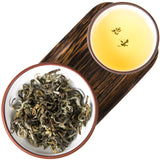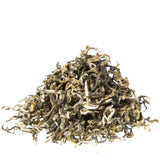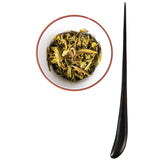DUE TO HIGH DEMAND, THIS TEA IS OUT OF STOCK
IT WON'T BE AVAILABLE UNTIL THE NEXT HARVEST IN SPRING.
SIGN UP FOR OUR NEWSLETTER TO STAY UPDATED
The young monk took a sip and looked up, puzzled – "Is this a white tea?"
Lao Cha raised an eyebrow – "Why do you ask?"
– "It's... full-bodied. There's something sweet, like ripe fruit. And something else — almost like bell pepper. And creamy."
Lao Cha nodded – "It's from Nepal. A place tucked high up in the Himalayas. They grow a cultivar there called Ghumti. It doesn't behave like the white teas that you know. Simple processing, done with care, keeps the tea true to its origins. What you're tasting is Ghumti being Ghumti: the place it comes from, the people who make it — that's what you're tasting."
The disciple took another sip. This time, he didn't say anything. He just sat with it.
This white tea comes from the Mahabharata hills of Ilam in eastern Nepal, right along the border with Sikkim. The area is renowned for its clean air, lush forests, and rolling green hills dotted with tea bushes. It sits high up, between 1000 and 2200 meters above sea level. That elevation, along with the cool, misty climate, gives the tea its signature high-mountain clean, vibrant qualities that you can taste right away.
The tea is made from Ghumti, a cultivar that's locally recognized in Ilam and used for high-end orthodox and white teas. This one's picked early in the season, plucked as buds and top leaves, and then lightly withered and dried to preserve freshness.
It's got a fuller body than you might expect from a white tea. The taste has soft floral notes but also a gentle spiciness reminiscent of green bell peppers, which gives it a little edge. There's a muscatel-like sweetness and a creamy mouthfeel – classic attributes of high-elevation teas from the Himalayas. All these qualities make this tea a great representative of the Himalayan Ghumti White Tea.
Tea has been grown in Ilam for over a century, but it's only in recent years that more care has gone into making high-quality loose-leaf teas. In Nepal, in many ways, it's still a young craft, and that's part of what makes it exciting – behind the tea, there is real energy and curiosity from the people who grow and make tea.
We source this tea through our new friend, Xiaofen, who runs a small tea shop in Kathmandu. Xiaofen is originally from Jiangxi, China – a region famous for green tea. She has been surrounded by tea most of her life. Xiaofen moved to Nepal in 2018, drawn by the mountains (and her now-husband), and decided to stay. Now, she works with small tea gardens in Nepal, sharing teas that she believes in. This one is one of her favorites, and we totally get it:)
Brewing guidelines:
![]() 185℉ / 85℃
185℉ / 85℃
 1g per 50-70ml
1g per 50-70ml ![]() 3-5min
3-5min
 1g per 20ml
1g per 20ml ![]() 5sec + 5sec for each subsequent infusion
5sec + 5sec for each subsequent infusion





